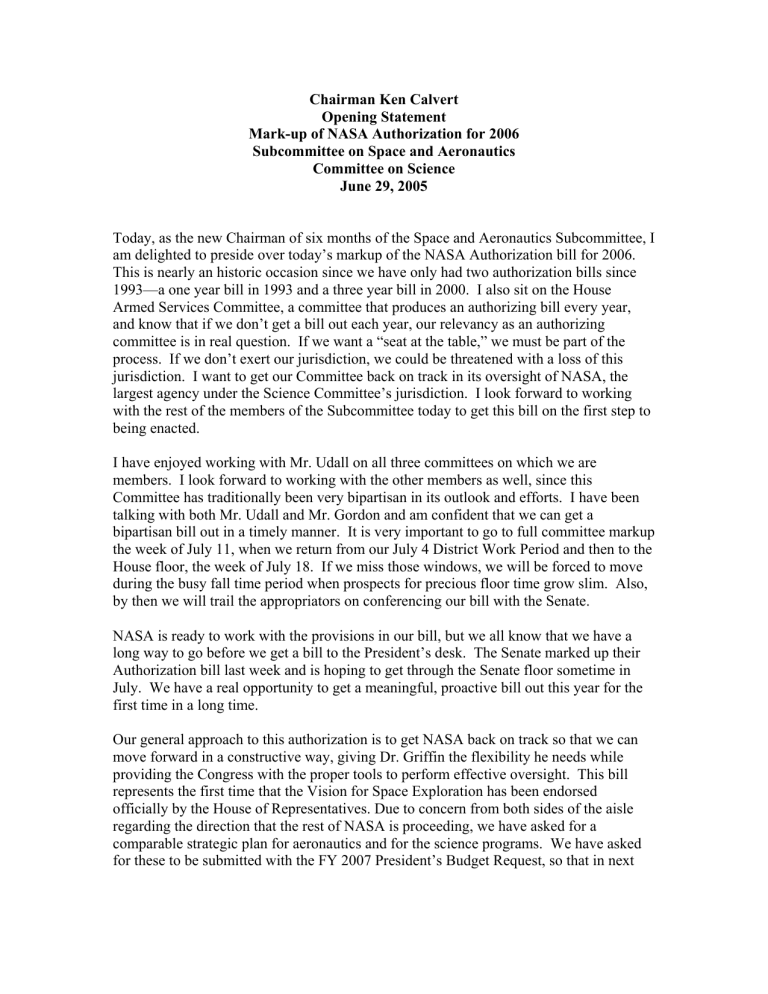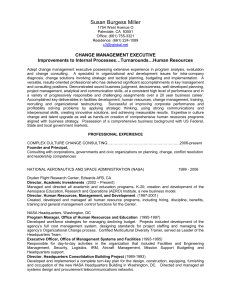Chairman Ken Calvert Opening Statement Mark-up of NASA Authorization for 2006

Chairman Ken Calvert
Opening Statement
Mark-up of NASA Authorization for 2006
Subcommittee on Space and Aeronautics
Committee on Science
June 29, 2005
Today, as the new Chairman of six months of the Space and Aeronautics Subcommittee, I am delighted to preside over today’s markup of the NASA Authorization bill for 2006.
This is nearly an historic occasion since we have only had two authorization bills since
1993—a one year bill in 1993 and a three year bill in 2000. I also sit on the House
Armed Services Committee, a committee that produces an authorizing bill every year, and know that if we don’t get a bill out each year, our relevancy as an authorizing committee is in real question. If we want a “seat at the table,” we must be part of the process. If we don’t exert our jurisdiction, we could be threatened with a loss of this jurisdiction. I want to get our Committee back on track in its oversight of NASA, the largest agency under the Science Committee’s jurisdiction. I look forward to working with the rest of the members of the Subcommittee today to get this bill on the first step to being enacted.
I have enjoyed working with Mr. Udall on all three committees on which we are members. I look forward to working with the other members as well, since this
Committee has traditionally been very bipartisan in its outlook and efforts. I have been talking with both Mr. Udall and Mr. Gordon and am confident that we can get a bipartisan bill out in a timely manner. It is very important to go to full committee markup the week of July 11, when we return from our July 4 District Work Period and then to the
House floor, the week of July 18. If we miss those windows, we will be forced to move during the busy fall time period when prospects for precious floor time grow slim. Also, by then we will trail the appropriators on conferencing our bill with the Senate.
NASA is ready to work with the provisions in our bill, but we all know that we have a long way to go before we get a bill to the President’s desk. The Senate marked up their
Authorization bill last week and is hoping to get through the Senate floor sometime in
July. We have a real opportunity to get a meaningful, proactive bill out this year for the first time in a long time.
Our general approach to this authorization is to get NASA back on track so that we can move forward in a constructive way, giving Dr. Griffin the flexibility he needs while providing the Congress with the proper tools to perform effective oversight. This bill represents the first time that the Vision for Space Exploration has been endorsed officially by the House of Representatives. Due to concern from both sides of the aisle regarding the direction that the rest of NASA is proceeding, we have asked for a comparable strategic plan for aeronautics and for the science programs. We have asked for these to be submitted with the FY 2007 President’s Budget Request, so that in next
year’s Authorization we will have the information we need to do successful oversight and to construct a more prescriptive NASA Authorization.
In addition to this, we have directed NASA to develop a Human Capital Strategy and to avoid any Reduction In Force or buyouts until this plan is submitted with the FY2007
President’s budget request as well. NASA facilities will have a parallel study, but we allow an additional year for this strategic plan because this is really even more dependent on NASA’s overall strategic plan.
We have requested that the Director of the Office of Science and Technology Policy
(OSTP) conduct a study to address the duplication of research and technology programs among federal agencies and whether research throughout the Federal government presents opportunities for collaboration and how it relates to for the national interest. We also direct OSTP to report back to the Congress on the funding invested by the government in each area.
We have included cost control language that is similar to that of this year’s House Armed
Services Committee’s Defense Authorization bill, which requires NASA to report to the
Congress annually on the status of “major” programs, defined as a program with a life cycle cost greater than $100 million. In the event that a major program is expected to exceed its original estimated development cost by 15% or the schedule by more than 6 months, NASA is required to notify Congress. If the development cost is expected to exceed original estimated development cost by 30%, Congress will have to evaluate whether to continue the program at all.
The bill contains authorization for a NASA Prize structure, modeled after the X-Prize that was won last year by famed aeronautics and aerospace engineer Burt Rutan and his
SpaceShipOne team. We do not limit the amount of the prize, but do require NASA to report to the Congress before offering any prize greater than $10 million.
We have a couple of housekeeping provisions that are included in this bill as well as H.R.
1022, The George E. Brown., Jr. Near Earth Object Survey bill, that was passed previously by this Committee, and H.R. 1023, The Charles “Pete” Conrad Astronomy
Awards Act, also previously passed by this Committee.
We have also authorized NASA’s top line at $16.471 billion as the level that the House
Appropriations bill included. This is about $15 million above the President’s FY2006 request. No other funding levels for programs are included.
I am looking forward to getting started today and taking the first step in producing a 2006
NASA Authorization bill.
Mr. Udall, do you have an opening statement?







